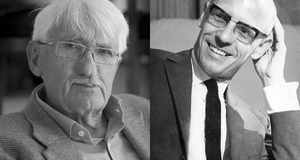Habermas's Linguistic Theory Applied to David Mamet's Films: Communicative Action in Action
By
2012, Vol. 4 No. 10 | pg. 2/2 | « Not only does it parallel Habermas’s concept of strategic action and perlocutionary aims, but it also suggests that there is no domain of life in which strategic action does not have the ability to permeate. This scene violates the belief that in a familial setting language use functions as a mode of communicative action where members reach mutually structured and cooperatively arranged agreements. Shelley allows his deviously veiled agenda to pervade that which is typically thought of as a sanctuary that excludes the pursuit of strategic action. Interestingly, there is only one scene in the entire film that could be considered an example of communicative action. This scene occurs near the end of the film, in which Shelley and Williamson are arguing over Shelley’s theft of the Glengarry leads from the real estate office. Williamson is about to enter into his office to notify the authorities that Shelley was one of the perpetrators of the crime, when Shelley stops him, pleading that he reconsider. When Williamson states that he will not, Shelley asks, “Why?” and Williamson responds, “Because I don’t like you” (Levin & Ruskin, 1992). Though an example of communicative action, even this represents a declaration of war, not serving in any manner to coordinate cooperative action. This sole instance of communicative action plainly reflects that language use as a means of cooperative communication has vaporized. The salesmen in the real estate office have effectively killed business by continually employing the use of strategic action.Mamet employs two distinct metaphors throughout the film to further illustrate this point. The first occurs in a discussion between Dave and George regarding how the sale of property has been converted into a contest, where one must battle to be number one on the board to win a Cadillac. Moss comments that the new style of striking a sale is no longer fair to the customer, stating, “What did I learn as a kid on Western? Don’t sell a guy one car, sell him five cars over fifteen years” (Levin & Ruskin, 1992). Referring to the new pressure management has placed on them to succeed, Moss further comments that, “They killed the goose” (Levin & Ruskin, 1992). This is a reference to the figurative ‘golden goose,’ and a direct metaphor for the destruction of language use as a means of coordinating mutual understanding. Secondly, Roma makes reference to the old ways of closing a deal, stating, “Dying breed. Yes it is. We are the members of a dying breed” (Levin & Ruskin, 1992). This similarly functions as a metaphor for the demise of language use as a means of cooperative communication. Mamet’s film artfully reinforces this conception of language use throughout the film by its manipulation of the weather. Throughout the film, Mamet intentionally stages an oppressive and dismal deluge through which the characters must plod in almost every scene. Such unrepentant rain is reminiscent of the biblical concept of Noah’s ark, in which God punished his people with the great flood that killed all but Noah and his family. The deluge in Glengarry Glen Ross parallels the biblical story, suggesting that the characters are also being punished for playing dangerously with language. Contrary to Glengarry Glen Ross, a second play to film adaptation by Mamet, American Buffalo, offers an interpretation upholding Habermas’s linguistic theory. Whereas the caustic real estate office in Glengarry Glen Ross was unable to craft interpersonal relations, American Buffalo provides a unique analysis of interpersonal relations in light of Habermas’s linguistic theory. Similar to Glengarry Glen Ross, American Buffalo portrays the corrosive effects of strategic language, depicting its potential to destroy relationships. Ultimately, however, the ending of Glengarry Glen Ross offers a poignant example of Habermas’s optimistic use of communicative action as a means for coordinating cooperation and reaching a mutually shared understanding. Through its portrayal of both strategic action and communicative action, Mamet’s analysis of linguistic interaction in contemporary circumstances depicted in this film provides support for Habermas’s linguistic theory. Mamet’s film centers on the conflict between business and friendship involving Donny, Teach, and Bobby. The film illustrates how the use of language in business dealings easily transforms friends into enemies. As stated by Teach, “The world is lies. There is no friendship” (Sloss, 1996). Echoing back to Glengarry Glen Ross, the deceptive perlocutionary effects in the realm of business, or perlocutionary effects3 as Habermas refers to them, reveals language’s potential to pit individuals against one another. The character of Teach best exemplifies this point. Teach says, “All I’m saying is don’t confuse business with pleasure. Loyalty is fine, but this is business” (Sloss, 1996). Jealous that Donny has chosen young and inexperienced Bobby to commit the crime of breaking into a presumed coin dealer’s house to steal back the buffalo nickel that Donny sold, Teach feels offended at not being offered to be part of the criminal plot. He argues that because Bobby does not have experience in such matters, Donny would do better to make Teach his closest accomplice. Teach has a manner of repeating phrases continuously and with great fervor, so that Donny eventually agrees that Bobby is not fit for the job. Whether or not Teach actually believes that Bobby is fit for the job is debatable; what is important in this context is that Teach is ultimately successful in convincing Donny to let him be his right-hand man, achieving the aim of his deceptive perlocutionary effect3 through a massive manipulation of language. Donny best explicates this by his reference to Shakespeare’s Othello. Othello accuses Iago of pouring poison in his ear as a metaphor for instilling suspicions against his wife Desdemona in order to destroy their relationship. Similarly, Donny states, “You stiff this one, you stiff that one…you come in here, you stick this poison in me…” (Sloss, 1996), referring to Teach’s attempt to break the father-son bond evidenced between Donny and Bobby in the film. Bobby is similarly guilty of employing strategic action, even if his motivations were not predatory and destructive such as those of Teach. Early in the film Bobby tells Donny that he followed the presumed coin collector to his house. It is not until the end of the film, that the audience realizes that Bobby’s true aim appears to have been driven by his fear to disappoint a father figure. Bobby believed that pursuing this venue would prompt Donny to bond closer with him in the father-son relationship that Donny had already begun to cultivate. This aim must be indirectly reconstructed by the hearer in order to be understood, best classified under Habermas’s explication of perlocutionary effects3. The continual pursuit of strategic action leads to a breakdown in the three character’s shared lifeworld. They have lost the ability to reach mutually and cooperatively structured agreements, as they no longer rely upon shared background knowledge to understand the intentions of the speaker. By the climax of the film, when Bobby tells Donny and Teach that he lied about following the presumed coin collector to his home, culminating with Teach hitting Bobby in the head with a phone, language use for cooperative communication is utterly lost. The conversation is no longer logical and is used to primarily convey insults and pose interrogatives that go unanswered, upending the presence of any criticizable validity claims needed for communicative action to come to fruition. They have destroyed the lifeworld in which they lived, symbolized by Donny’s utterly demolished shop. This supports Habermas’s claim that the lifeworld and communicative action are intertwined. Referring to the reproduction of the lifeworld in terms of social integration, cultural reproduction, and socialization, respectively synonymous with regulative, constative, and expressive speech acts, Habermas (1998) states, “Nonetheless, these components of the lifeworld should not be conceived of as systems constituting environments for one another; they remain entwined with one another via the common medium of everyday language” (p. 250). The incoherent language reveals that the breakdown of cooperative language use ensures the breakdown of the lifeworld. With this breakdown the characters have been cleaved open and vulnerably exposed, epitomized by the pig split that Teach handles in Donny’s shop. Ironically though, the end of the film reinforces the Habermasian point that the breakdown of the lifeworld can be rectified through cooperatively structured communicative interaction. In the ending dialogue, the three characters restore the interpersonal relations that were severed with the breakdown of the lifeworld. Bobby and Donny both exchange apologies; Donny and Teach establish a mutual understanding that the planned robbery can no longer take place and that Bobby must be taken to the hospital immediately. Each of these is coordinated through the use of language to reach a mutual understanding. The characters restore the lifeworld through the use of communicative action. Communicative action, “…is embedded in a lifeworld that provides risk-absorbing coverage in the form of a massive background consensus. The explicit feats of communication achieved by communicative actors take place within the horizon of shared, unproblematic convictions” (Habermas, 1998, p. 237). Once the characters aim toward a mutual understanding, they can again rely upon this ‘massive background consensus,’ as a cooperative tool for language users, allowing them to make amends and deliver Bobby to the hospital. Though a dark film, the ending is ultimately hopeful, reinforcing Habermas’s optimistic theory of language use. The third and final film in this Mamet play to film trilogy, Oleanna, ultimately presents the most substantial and sustained critique against Habermas’s theory of the rational potential of communication. Oleanna fundamentally provides two important concepts that reveal the deficiencies of Habermas’s theory. First, Mamet offers a narrative of language use as a repository of power, demonstrating that in contemporary circumstances, language can be used as a power structure for manipulation. Secondly, the transformational development of the characters in the film prompts one to question why Habermas does not offer an existential explanation of how one becomes a competent language user. While there are some Habermasian moments in the film, taken as a whole, the film portrays the flaws inherent in Habermas’s linguistic theory. Oleanna can primarily be viewed as a film centered upon power. From the very beginning of the film, one understands that John, the professor, retains the ability to exercise power over his students. John desires to indoctrinate his students according to his lesson plan, described in his own words that, “Education is prolonged and systematic hazing” (Green & Wolff, 1994). When Carol enters his office confused and asking for extra assistance, John primarily views this an extended opportunity to reinforce the primary component of his lesson plan, which is perhaps best summarized as his beliefs and not impartial instruction. John recognizes that with his position as a professor, he shapes young minds dependent upon the information that he supplies. Thus, Carol is viewed as more of an object, or repository, which John can fill with his own ideas and beliefs. Although indirect and mild, John repeatedly commands that Carol, “Here, please. Sit down” (Green & Wolff, 1994), depicting power and submission through the positioning of the characters. By asking Carol to take a demur, feminine, position John stands tall and flaunts his knowledge that his position of power has given him the tools to command as he pleases. Although John indeed says, “I have no desire other than to help you,” (Green & Wolff, 1994), intentions ultimately do not have authority when it comes to questions of power. However, by the end of the film, the audience sees the dynamics of power transition from John to Carol, entailing an utter reversal. Ironically enough, Carol not only teaches John that education is not the farcical institution that John takes it to be, but also teaches him about societal privilege and the proper treatment of women. Carol’s formal complaint to the tenure committee on charges of sexual harassment ultimately results in the loss of John’s job. Contrary to her inarticulate pleading for assistance in John’s office at the beginning of the film, Carol returns with the pronounced ability to enumerate John’s flaws, stating, “You’ve worked twenty years for the right to insult me” (Green & Wolff, 1994). She succinctly states that John indeed was the one with the power originally, stating, “Do you know what you’ve worked for? Power! For power. Do you understand” (Green & Wolff, 1994)? In turn, Carol demonstrates the ability to exercise her newfound power, telling John that she will drop her charges against him if he will agree to accept ‘her group’ of student’s list of banned books. Carol demonstrates that she indeed has the power to drastically change John’s life. The last few lines of the film most potently portray this. After assaulting Carol and realizing what he has done, John says, “Oh, my God” (Green & Wolff, 1994). Carol interprets this phrase in an entirely different manner stating, “Yes, that’s right” (Green & Wolff, 1994), affirming that similar to God, she now possesses ultimate power. Such a depiction of power in this film, presents an argument against Habermas’s theory that language use is a reservoir of reason. The pursuit of power and the ability to use power to achieve one’s aims does not allow for rational language use. The lifeworld is severed and remains in a state of breakdown, disallowing communicative action to repair, restructure, and reproduce the lifeworld. One might argue that the final scene of the movie, with the two college-aged kids throwing and catching a ball, or ‘connecting,’ serves as a parallel for communicative action where one ‘intercepts and connects’ with another’s speech act; this appears to support the claim that the lifeworld has moved past its breakdown allowing for communicative interaction. However, in rebuttal, this scene does not show any manner of reconciliation between Carol and John, the two characters from whom this breakdown of the lifeworld is predicated upon. Thus, this ending scene does not buttress Habermas’s theory. However, Carol’s acquisition of power cannot be effectively understood until one recognizes her existential transformation that takes place from the beginning to the end of the film. In the beginning of the film, Carol questions all of John’s assertions, continuing to repeat the phrase, “I don’t understand” (Green & Wolff, 1994). Carol reveals that she is not a competent language user, as she is unable to grasp simple terms and concepts set out by way of language. Carol continues submissively abiding by John’s command to sit down, until John gives Carol a cup of tea. At first Carol acts demurely, the very picture of Victorian femininity, with her fine bone china balanced delicately on her lap. Yet as John continues to exploit his power by deliberately speaking over Carol and disrupting her utterances, Carol intentionally drops the cup and says, “I believe that I am speaking” (Green & Wolff, 1994). During this pivotal scene, John drops to one knee, a gesture typically associated with subservience, showing that Carol is now the one finding the resources to assert herself as a competent and effective language user. Later in the film, when Carol associates with her ‘group,’ of students, she acquires a true sense of self, or standing, feeling empowered by her ‘group’s’ desire that she represent them. Carol now takes herself as an agent able to speak. This transformation is further evidenced by the transformation in Carol’s manner of dress throughout the film. In the beginning, Carol enters wearing Levis and a baggy sweater, her disheveled look paralleling her inability to use language competently. Yet by the end of the film, Carol enters in a two-piece suit, demonstrating that she acquired the ability not only to present herself competently and professionally, but also to speak in this same manner. Habermas’s linguistic theory offers a structure of development, but not a dynamic of one’s development as an agent moving through that structure of development. One does not suddenly become a competent language user, but Habermas appears to make the assumption that one does, omitting an explanation. Carol presents an interesting question. Prior to her ability to competently use speech, would she have been considered a part of the lifeworld? One must know how this individual transformation comes about to better understand the complexity of speech and when one acquires one’s stance as both a speaker and a hearer. Habermas appears to have left a vital question untouched. After outlining Habermas’s linguistic theory and placing it in light of David Mamet’s three films, I argue that while Habermas makes a crucial and valid point with his theory of communicative action, there are also aspects of his theory that are problematic. The theory should not be entirely discredited but understood in light of its shortcomings. Habermas’s theory of the rational potential of language presents a valid argument in that there are many situations within his tripartite structure of facts, norms, and feelings in which individuals employ communicative action to reach an understanding with another. Communicative action is indeed an essential and integral component of everyday interaction with others in the lifeworld. American Buffalo depicts the ability of individuals to coordinate with others to reach a cooperative understanding, as seen when Donny and Teach are able to overcome the breakdown of their lifeworld through communicative action and arrive at a shared understanding to take Bobby to the hospital. However, Habermas’s theory is not without its flaws. Glengarry Glen Ross provides a venue by which to critique Habermas’s concept that communicative action repairs the breakdown of the lifeworld. One sees that the film presents an example in which communicative action does not repair the breakdown situation; even the sole use of communicative action represents an injurious exchange. In contemporary linguistic interaction, communicative action does not always have the potential to repair the breakdown of the lifeworld. It is Oleanna, however, that presents the most substantial and sustained critiques against Habermas. Though language use does act as a reservoir of reason, it also functions as a repository to attain and exploit power. Furthermore, Habermas does not provide an existential developmental logic, of how one becomes a competent speaker, but rather assumes that one has already become a capable speaker. Despite the critiques levied against Habermas through Mamet, Mamet illustrates that in order to resolve problems encountered in everyday situations, it would serve one best to adopt ways of democratically repairing situations. While Mamet does point out the flaws of Habermas’s linguistic theory, his bleak and devastating films also function to reinforce Habermas’s concept that communicative action is necessary in order to diplomatically solve dilemmas and prevent destructive situations. The absence of communicative action in Glengarry Glen Ross and Oleanna leaves the audience depressed and forlorn whereas the recourse to communicative action in American Buffalo offers a glimmer of hope that the debris from the character’s linguistic warfare can potentially be liquidated, allowing them to begin anew. To avoid a world in which situations parallel the dark, ominous world of linguistic malfunction presented by Mamet, the lifeworld must rely upon the Habermasian concept of communicative action to continue to propagate the lifeworld and offer the flicker of hope evidenced in American Buffalo. A symbiotic relationship between Habermas’s philosophical idealism and Mamet’s sociologically realistic account is necessary to portray an accurate representation of linguistic philosophy. For sociological realism without philosophical idealism is normatively blind, and philosophical idealism without sociological realism will forever be sociologically empty. ReferencesSloss, John (Producer), & Corrente, Michael (Director). (1996). American Buffalo [Motion Picture]. United States: Hallmark Entertainment. Levin, Nava & Ruskin, Morris (Producers), & Foley, James (Director). (1992). Glengarry Glen Ross [Motion Picture]. United States: Artisan Home Entertainment. Jürgen Habermas. (1996). Between facts and norms: Contributions to a discourse theory of law and democracy. (William Rehg, Trans.). Cambridge, MA: MIT. Jürgen Habermas. (1998). On the pragmatics of communication. Maeve Cooke (Ed.). Cambridge, MA: MIT. Green, Sarah & Wolff, Patricia (Producers), & Mamet, David & Tulliver, Barbara (Directors). (1994). Oleanna [Motion Picture]. United States: Hallmark Entertainment. Endnotes
Suggested Reading from Inquiries Journal
Inquiries Journal provides undergraduate and graduate students around the world a platform for the wide dissemination of academic work over a range of core disciplines. Representing the work of students from hundreds of institutions around the globe, Inquiries Journal's large database of academic articles is completely free. Learn more | Blog | Submit Latest in Film & Media |


















